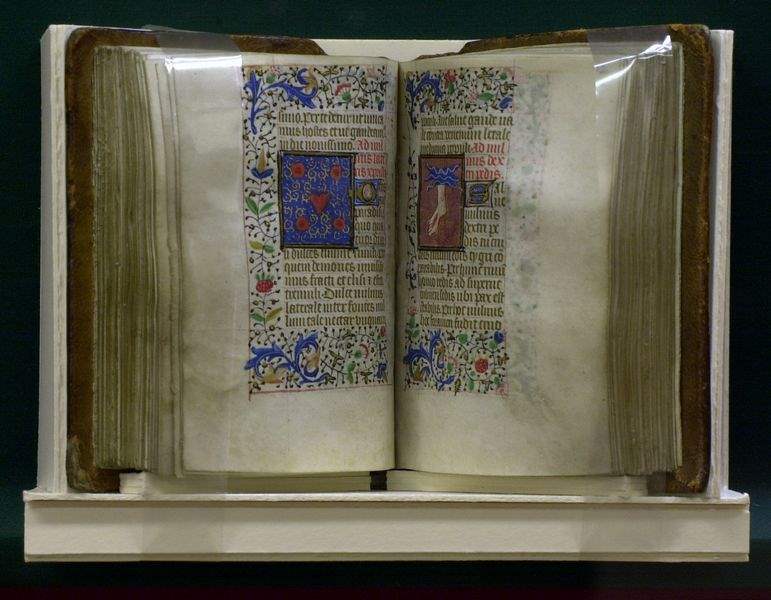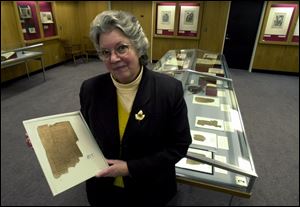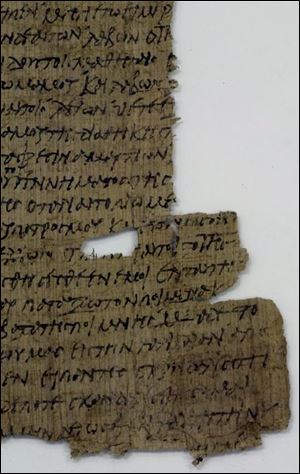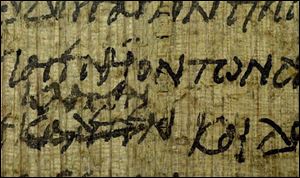
The holy collection
1/20/2001
The original Book of Hours from The Netherlands is pocket-sized at three inches by four inches and dates back to the second quarter of the 15th century.
ANN ARBOR, Mich. - Imagine a time when a copy of the Holy Bible was so valuable it had to be chained to the lectern. That was common practice hundreds of years ago when the books represented sizable investments in time, energy, and materials.
Scriptures were meticulously copied by hand onto vellum - fine paper made of calfskin or vegetable parchment - with illustrations individually applied by artists and then bound into volumes by skilled craftsmen.
A miniature copy of a chained Bible is one of many items making up a remarkable exhibit, “From Papyri to King James: The Evolution of the Bible,” on display through the end of the month at the University of Michigan.

Librarian Kathryn Beam holds a papyrus codex of the Letters of St. Paul in Greek.
Among the exhibit highlights:
The Bibles and manuscripts are part of the university's permanent collection and have been put on display every December and January since 1983, said Kathryn Beam, a special collections librarian. “People expect to see it this time of year and many travel great distances to come here.”
Most of the items were donated by William C. Hollands, who served as superintendent of printing and binding at the university's library bindery from its inception in 1896 until his semi-retirement in 1929.
In 1935, Mr. Hollands donated a large number of Bibles and manuscripts to UM in establishing the William Tinker Hollands Memorial Collection, named in honor of his son. He continued to work at the university part time in his retirement, and, after his death in the late 1940s, his estate bequeathed most of the remaining Bibles in his collection to the university, according to Ms. Beam.

A papyrus fragment written in Koine Greek details the Last Supper and the Betrayal.
The 46 items on display date between 119 A.D. and 1999 and are kept in humidity and temperature-controlled glass cases on the seventh floor of the university's Harlan Hatcher Graduate Library.
At first glance, it's an unassuming collection. The medium-sized room contains a few rows of glass displays on the floor and a few more on the walls. There is little indication that this is a major exhibit, but as visitors peruse the glass cases, tracing the evolution of the Bible through the centuries, the wonders of this exhibit slowly unfold.
“Ann Arbor is the place to go in the United States for this,” said Brent Walters, a California-based authority on Bible history and founder of the Web site ChurchHistory.com.
The two oldest manuscripts, or codex, in the exhibit are not biblical texts but historical documents that add background to the books of the Bible. Written in Greek on papyrus, the first includes census data from the year 118 from the village of Bacchias, near modern Cairo. The other, showing a touch of spiritual chaos in early Christianity, includes both a Judeo-Christian reference to God as “Lord ruler of all” and a word commonly used at the time for magic, “ablanathanalba.”

This papryi fragment from the 3rd or 4th century has a copy error and the correction. The writing is from Matthew 26:19-52.
One papyrus, dated circa 125 A.D., includes the last line of Saint Paul's letter to the Romans and the first 20 lines of his epistle to the Ephesians. The codex is more than 100 years older than any previously discovered copies of Paul's letters.
Another impressive item is the Vulgate Bible, written in Latin and produced in either France or Italy in the 13th century. The lavishly illustrated book is opened to a page decorated with a portrait of Saint Paul in gold and silver paint. The Vulgate - its name is derived from the Latin word for common - was translated by Saint Jerome in 404 A.D. and for centuries was the standard interpretation.
A 12th century copy of the Gospel of Luke, written in a sharply angled, interwoven text known as littera textura, includes extensive commentary in the margins from early church scholars.
A leaf from the 42-Line Bible, commonly called the Gutenberg Bible, is on display. Dating to 1456, it was the first book printed in a western language with moveable type.
Also included in the exhibit is the first copy of the New Testament printed in Greek, which was achieved by Basel printer Johann Froben in 1516.
William Tyndale's translation of the New Testament, printed in 1536, is one of only two copies known to exist. Tyndale paid the ultimate price for his work, which was condemned as heresy by the English bishops, who sentenced Tyndale to be burned at the stake.
The King James Bible, endorsed by James I of England, was printed in 1611 and is still in widespread use today. An original first edition copy is included in the display, as is a luxurious 1999 printing of the King James with illustrations by Barry Moser.
Elaborate woodcuts and copper engravings by Renaissance artist Albrecht Durer add visual beauty to the exhibit. “God is honored when it appears that He has given such insight to a creature in whom such art resides,” wrote Durer, who lived in Germany from 1471 to 1528.
The exhibit is open 10 a.m.-5 p.m. Monday-Friday and 10 a.m.-noon Saturday through Jan. 31. Information is available at 734-764-9377. A CD-ROM about the exhibit sells for $47.96 (call 800-876-1922 for information).
A portion of the exhibit can be seen online at http://www.lib.umich.edu/libhome/SpecColl.lib/spec_coll.html.